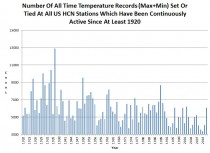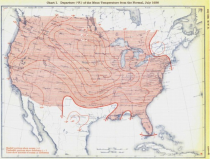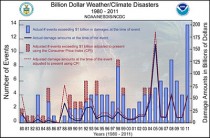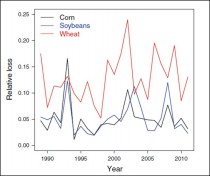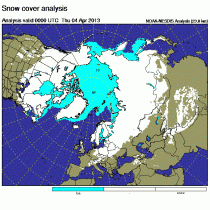Steve Goddard, Real Science
Paul Homewood brought this to our attention yesterday - NOAA’s climate extreme index is a complete fraud.
They show that temperature extremes were very rare during the 1930s, and very common now.

U.S. Climate Extremes Index enlarged
In fact, it is the exact opposite. The graph below plots the number of all-time daily temperature records set or tied at all USHCN stations which have been continuously active since at least 1920. It is almost exactly the opposite of NOAA’s claims.
Temperature-wise, 1936 was by far the most extreme year in US history - and NOAA shows it as being one of the least extreme. Unbelievable.
February, 1936 was the coldest month in US history, and July 1936 was second hottest month in US history after July, 1901.
docs.lib.noaa.gov/rescue/mwr/064/mwr-064-02-c1.pdf
docs.lib.noaa.gov/rescue/mwr/064/mwr-064-07-c1.pdf
Either NOAA knows nothing about US climate history, or they are intentionally deceiving the public.
By Roger Pielke Jr.
The National Oceanic and Atmospheric Administration keeps a tally of “billion dollar disasters” which have occurred in the United States. The number of disasters which exceed the billion dollar threshold has increased since 1980. This increase has been often cited as evidence that the climate has become more extreme and is attributable to emissions of carbon dioxide. A new peer-reviewed paper from NOAA pours cold water on both claims.
Adam Smith, of NOAA, and Rick Katz, a statistician and former colleague of mine at NCAR, have a paper just out in the journal Natural Hazards in which they take a close look at the index. What they find reinforces conclusions found in earlier work on disasters and climate change. Specifically, if you are looking for climate signals in extreme events, look first at climate data. If you are looking at loss data, avoid aggregated, non-normalized loss records.
Here is what the new analysis finds:
1. The number of billion dollar disasters has increased by about 5% per year since 1980, but (perhaps surprisingly) the loss per event has not:
[T]here is no apparent time trend in economic loss from individual disasters. In fact, a least squares trend analysis estimates a very slight decreasing trend of about 0.5 % per year.
So they find more events that exceed the billion dollar threshold, but not more severe events.
2. The dataset is dominated by hurricane, drought and thunderstorm losses which together account for more than two thirds of all events and more than 80% of all losses. As readers here will know well, there are no long-term trends in normalized US hurricane losses, North American drought has decreased and there has been no increase in tornado damage (note that thunderstorm damage also includes hail and straightline winds). This alone provides a strong caution to using the NOAA index for purpose of claims about extremes in general.
3. The new paper warns on the use of crop losses, which are included in the NOAA data in the loss categories of tropical cyclone, severe storm, winter storm, wildfire, drought/heat, flooding and crop freeze—that is to say, in every category. The warning is that:
Given the increasing trends in [crop] yields attributable to technological innovation and given fluctuations in price, it is difficult to attribute any part of the trends in losses to climate variations or change, especially in the case of billion-dollar disasters.
In fact, one of the most important contributions of the paper might be its finding that crop losses have not increased as a proportion of liability (as shown in the figure above from the paper), or as it concludes,""for these three major crops, the trends in losses are comparable in magnitude to the trends in liability.”
The billion dollar loss dataset includes no adjustments for changes in crop value, yield or other relevant factors, nor does the widely cited Munich Re data. The implication of course is that some significant but unquantified portion of the increase in billion dollar losses reflects non-climatic trends in crop production and value.
4. Their paper concludes by noting the the billion dollar disaster database is adjusted only for inflation and has not been normalized to account for other changes. They explain that
The magnitude of such increasing trends is greatly diminished when applied to data normalized for exposure (Pielke et al. 2008).
Smith and Katz have properly identified the severe limitations to the NOAA billion dollar loss database. Any bets as to whether NOAA will issue a press release as a corrective to its earlier hyping of the index and promoting its misuse? Even if they don’t, the new paper is a valuable contribution.
Energy Secretary Steven Chu, a Nobel Prize-winning physicist frequently the target of Republican criticism, announced Friday that he was stepping down in the The latest shake-up of President Barack Obama’s Cabinet. Chu, who disclosed his decision in a letter to Energy Department staff, frequently clashed with GOP lawmakers over gas prices as well as government backing for green-energy companies like the failed firm Solyndra.
In his letter, Chu took aim directly at his critics, saying the clean-energy efforts were a success - and blasted climate-change skeptics as trapped in “the Stone Age.”
“While critics try hard to discredit the program, the truth is that only one percent of the companies we funded went bankrupt,” he wrote. “That one percent has gotten more attention than the 99 percent that have not.”
Chu added: “The test for Americaís policy makers will be whether they are willing to accept a few failures in exchange for many successes. America’s entrepreneurs and innovators who are leaders in the global clean energy race understand that not every risk can - or should - be avoided. Michelangelo said, ‘The greater danger for most of us lies not in setting our aim too high and falling short; but in setting our aim too low, and achieving our mark.’”
He also scolded climate-change skeptics and urged a shift from fossil-fuels to other sources of energy.
“The overwhelming scientific consensus is that human activity has had a significant and likely dominant role in climate change,” Chu warned in his letter.
“There is also increasingly compelling evidence that the weather changes we have witnessed during this thirty year time period are due to climate change.”
Chu underlined that China was pushing ahead with clean-energy investments - outpacing U.S. efforts.
“While we cannot accurately predict the course of climate change in the coming decades, the risks we run if we donít change our course are enormous. Prudent risk management does not equate uncertainty with inaction,” he said. “The Stone Age did not end because we ran out of stones; we transitioned to better solutions.”
In a written statement, Obama praised Chu for giving the Energy Department “a unique understanding of both the urgent challenge presented by climate change and the tremendous opportunity that clean energy represents for our economy.”
Obama added, “And during his time as Secretary, Steve helped my Administration move America towards real energy independence. Over the past four years, we have doubled the use of renewable energy, dramatically reduced our dependence on foreign oil, and put our country on a path to win the global race for clean energy jobs. I wish him all the best.”
Chu will likely stay in his post through the end of February, though it will depend on the confirmation of his successor.
Anthony Watts
While dodging the issue of his own ten thousand dollar speaking fees this past week, Mike Mann thinks its all a big hugely funded conspiracy (like those WUWT calendar sales). From a hilarious interview at The Independent:
A climate scientist who says he has been subjected to a vitriolic hate campaign has denounced the way that American billionaires have been able to secretly finance the climate-sceptic organisations that have attacked him.
Professor Michael Mann of Pennsylvania University, who has been targeted by climate-change sceptics for his work on global temperature records, said it was wrong for wealthy individuals such as the oil billionaire Charles Koch to surreptitiously finance the “counter-movement” that denounces the science of global warming.
It was only when he was researching a book that he became aware Koch was assisting some of the organisations that he says have been attacking him and his colleagues for so many years, Professor Mann said. He said the sceptic organisations had “single-handedly sought to poison the public discourse over human-caused climate change. In the process they have potentially mortgaged the futures of our children and grandchildren. You couldn’t invent villains like this if you tried.”
From: Top climate scientist denounces billionaires over funding for climate-sceptic organisations in the The Independent
On the subject of the Koch Brothers and funding of sceptic organizations, Dr. Mann might recall that his criminal acquaintance, Dr. Peter Gleick’s document theft was helpful it putting that issue to rest once and for all. From Junkscience.com
As this page shows, the Charles G. Koch Charitable Foundation only gave $25,000 to Heartland in 2011 (about 0.5% of Heartland’s budget) for a health care project. Heartland only hoped to get $200,000 from the Foundation in 2012 - again for its health care project. But Dr. Mann would never talk about such adverse results.
Nor does Dr. Mann like to talk about the millions he has received in grants at Penn State.
From the American Spectator:
Inarguably the next-largest culprit is Michael Mann, Mr. Nature Trick, who is not to be confused with the Nature Boy or the other “Heat” - making Mann. He has had his grants available for public viewing for a while, so I’m surprised I’ve not seen those spread around the ‘Net. They are right there listed in his curriculum vitae. (now deleted - AW)
2009-2013 Quantifying the influence of environmental temperature on transmission of vector-borne diseases, NSF-EF [Principal Investigator: M. Thomas; Co-Investigators: R.G. Crane, M.E. Mann, A. Read, T. Scott (Penn State Univ.)] $1,884,991
2009-2012 Toward Improved Projections of the Climate Response to Anthropogenic Forcing: Combining Paleoclimate Proxy and Instrumental Observations with an Earth System Model, NSF-ATM [Principal Investigator: M.E. Mann; Co-Investigators: K. Keller (Penn State Univ.), A. Timmermann (Univ. of Hawaii)] $541,184
2008-2011 A Framework for Probabilistic Projections of Energy-Relevant Streamflow Indices, DOE [Principal Investigator: T. Wagener; Co-Investigators: M. Mann, R. Crane, K. Freeman (Penn State Univ.)] $330,000
2008-2009 AMS Industry/Government Graduate Fellowship (Anthony Sabbatelli), American Meteorological Society [Principal Investigator: M.E. Mann (Penn State Univ.)] $23,000
2006-2009 Climate Change Collective Learning and Observatory Network in Ghana, USAID [Principal Investigator: P. Tschakert; Co-Investigators: M.E. Mann, W. Easterling (Penn State Univ.)] $759,928
2006-2009 Analysis and testing of proxy-based climate reconstructions, NSF-ATM [Principal Investigator: M.E. Mann (Penn State Univ.)] $459,000
2006-2009 Constraining the Tropical Pacificís Role in Low-Frequency Climate Change of the Last Millennium, NOAA-Climate Change Data & Detection (CCDD) Program [Principal Investigators: K. Cobb (Georgia Tech Univ.), N. Graham (Hydro. Res. Center), M.E. Mann (Penn State Univ.), Hoerling (NOAA Clim. Dyn. Center), Alexander (NOAA Clim. Dyn. Center)] PSU award (M.E. Mann): $68,065
2006-2007 Acquisition of high-performance computing cluster for the Penn State Earth System Science Center (ESSC), NSF-EAR [Principal Investigator: M.E. Mann, Co-Investigators: R. Alley, M. Arthur, J. Evans, D. Pollard (Penn State Univ.)] $100,000
2003-2006 Decadal Variability in the Tropical Indo-Pacific: Integrating Paleo & Coupled Model Results, NOAA-Climate Change Data & Detection (CCDD) Program [Principal Investigators: M.E. Mann (U.Va), J. Cole (U. Arizona), V. Mehta (CRCES)] U.Va award (M.E. Mann): $102,000
2002-2005 Reconstruction and Analysis of Patterns of Climate Variability Over the Last One to Two Millennia, NOAA-Climate Change Data & Detection (CCDD) Program [Principal Investigator: M.E. Mann, Co-Investigators: S. Rutherford, R.S. Bradley, M.K. Hughes] $315,000
2002-2005 Remote Observations of Ice Sheet Surface Temperature: Toward Multi-Proxy Reconstruction of Antarctic Climate Variability, NSF-Office of Polar Programs, Antarctic Oceans and Climate System [Principal Investigators: M.E. Mann (U. Va), E. Steig (U. Wash.), D. Weinbrenner (U. Wash)] U.Va award (M.E. Mann): $133,000
2002-2003 Paleoclimatic Reconstructions of the Arctic Oscillation, NOAA-Cooperative Institute for Arctic Research (CIFAR) Program [Principal Investigators: Rosanne DíArrigo, Ed Cook (Lamont/Columbia); Co-Investigator: M.E. Mann] U.Va subcontract (M.E. Mann): $14,400
2002-2003 Global Multidecadal-to-Century-Scale Oscillations During the Last 1000 years, NOAA-Climate Change Data & Detection (CCDD) Program [Principal Investigator: Malcolm Hughes (Univ. of Arizona); Co-Investigators: M.E. Mann; J. Park (Yale University)] U.Va subcontract (M.E. Mann): $20,775
2001-2003 Resolving the Scale-wise Sensitivities in the Dynamical Coupling Between Climate and the Biosphere, University of Virginia-Fund for Excellence in Science and Technology (FEST) [Principal Investigator: J.D. Albertson; Co-Investigators: H. Epstein, M.E. Mann] U.Va internal award: $214,700
2001-2002 Advancing predictive models of marine sediment transport, Office of Naval Research [Principal Investigator: P. Wiberg (U.Va), Co-Investigator: M.E. Mann] $20,775
1999-2002 Multiproxy Climate Reconstruction: Extension in Space and Time, and Model/Data Intercomparison, NOAA-Earth Systems History [Principal Investigator: M.E. Mann (U.Va), Co-Investigators: R.S. Bradley, M.K. Hughes] $381,647
1998-2000 Validation of Decadal-to-Multi-century climate predictions, DOE [Principal Investigator: R.S. Bradley (U. Mass); Co-Investigators: H.F. Diaz, M.E. Mann]
1998-2000 The changing seasons? Detecting and understanding climatic change, NSF-Hydrological Science [Principal Investigator U. Lall (U. Utah); Co-investigators: M.E. Mann, B. Rajagopalan, M. Cane] $266,235K
1996-1999 Patterns of Organized Climatic Variability: Spatio-Temporal Analysis of Globally
Distributed Climate Proxy Records and Long-term Model Integrations, NSF-Earth Systems History [Principal Investigator: R.S. Bradley (U. Mass); Co-Investigators: M.E. Mann, M.K. Hughes] $270,000
1996-1998 Investigation of Patterns of Organized Large-Scale Climatic Variability During the Last
Millennium, DOE, Alexander Hollaender Postdoctoral Fellowship [M.E. Mann] $78,000
For those keeping score, thatís almost $6 million total for various predictions, models and reconstructions over the last 13 years by Mann and his playmates.
As for the “villains”, I’m reminded of this famous quote from Dr. Roger Pielke Jr.:
If Michael Mann did not exist, the skeptics would have to invent him.
By KIMBERLEY A. STRASSEL Today’s WSJ
To approve natural gas exports and other energy projects, the president may demand a carbon tax President Obama set off a guessing game this week as to what he intended with his inaugural promise to double down on climate change. There’s no need to guess. California Democrat Barbara Boxer, the Senate’s climate guru, was happy to fill in the gory details.
The president’s climate shout-out sent the green community into flurries of ecstasy, with grand hopes of a new push for cap-and-trade in Congress, or of a redoubled U.S. commitment to a global carbon pact. It fell to Mrs. Boxer to tamp down those ambitions, even as she reassured her devotees that there is more than one way to skin the climate cat.
“A lot of you press me . . . on: ‘Where is the bill on climate change? Where is the bill?’ There doesn’t have to be a bill,” Mrs. Boxer explained in a briefing the day after Mr. Obama’s speech. “I’m telling you right now, EPA has the authority in the transportation sector, the electricity sector, and the industrial sector under the Clean Air Act” to do everything that legislation might otherwise.
In other words, with the election over, all pretense is gone. Democrats won’t waste political capital on a doomed cap-and-trade bill. Yet they’ll get their carbon program all the same, by deputizing the EPA to impose sweeping new rules and using their Senate majority to block any GOP effort to check the agency’s power grab. The further upside? Brute regulation is not only certain and efficient, it allows vulnerable Democrats to foist any blame on a lame-duck administration.
Mrs. Boxer has spent years on climate, and she wouldn’t be surrendering her legislative ambitions without clear assurances the White House has her covered. Her words were a signal that the Obama EPA is about to re-energize the regulatory machine that it put on ice during the election. Republicans who hoped Lisa Jackson’s resignation signaled a more humble EPA approach should instead prepare for an agency with a new and turbocharged mission.
Just as notable, Mrs. Boxer gave the clearest sign yet that Dems intend to simultaneously pursue the new holy grail of climate control: a carbon tax. The left has been ginning up enthusiasm for this energy tax, not only as a means of cutting fossil-fuel use, but as a way of generating enormous revenue to cover their spending ambitions. The Democrats’ political problem, however, is that the tax remains hugely unpopular.
Mrs. Boxer helpfully detailed Democrats’ new strategy for getting a foothold. Now that cars are so much more fuel-efficient, she explained, the gas tax isn’t bringing in enough revenue to cover highway needs. How to fix this? Easy! Just replace the gas tax with a carbon tax.
As strategy goes, this is clever. The gas tax itself is unpopular, so Democrats are betting on some public support for killing it. They figure at least some Republican porksters will salivate at more state highway money. Democrats can initially sell the tax as limited to covering infrastructure, knowing that once the principle is established, they can ramp up. And all this can be silkily pitched as part of “tax reform.”
The only thing Mrs. Boxer did not explain was how the administration intends to balance this climate crackdown with its position atop an American energy renaissance. Mr. Obama spent the past election year bragging that gas and oil production had risen on his watch, hoping to cadge some credit for the economic boom that has accompanied private-sector drilling advances.
The administration has kept open the possibility of approving the Keystone XL pipeline. It has hinted it will greenlight more export terminals for natural gas. It last week again delayed its fracking rules for public lands. These moves have encouraged the oil-and-gas industry, even as they have driven the environmental community nuts. The Natural Resources Defense Council this week declared that approving Keystone would be “fundamentally inconsistent” with Mr. Obama’s renewed vow to “address climate change.”
Or would it? Republicans might recollect that the Obama administration has a practiced method of winning controversial legislation like ObamaCare and Dodd-Frank. To wit, it uses a combination of bribes and threats to get pertinent sectors of the business community to back its efforts.
Consider what the mighty oil-and-gas lobby might be co-opted to do - either out of gratitude for the president’s backing or fear that he might turn on it. Consider how the political environment might change if the industry threw its weight behind a carbon tax or the EPA climate scheme. Consider that this might prove an easy call, given that a tax would be borne by its customers, while EPA regs will mostly crush coal. Consider that numerous Big Oil chieftains have already endorsed such a carbon levy. And who says Mr. Obama has to decide Keystone XL or anything else soon? He could hold out, to see what he can extract in return.
All this is food for thought for those conservatives who have been lulled into complacency by the stall of cap and trade. A big climate agenda is coming, only on very different terms. If Republicans hope to spare the economy that pain, it’s time to adapt.
Cornwall Alliance
Nothing better illustrates the great need to expose the corrupt and sloppy science and the moneyed interests propelling the global warming alarmist juggernaut than President Barack Obama’s comments on climate change in his second inaugural address.
As the Wall Street Journal pointed out, “One of his most passionate moments was ... devoted to addressing ‘climate change,’ of all things. ...Mr. Obama says it will be a major priority in the next four years.”
Here’s what President Obama said-with our responses:
“We, the people, still believe that our obligations as Americans are not just to ourselves, but to all posterity. We will respond to the threat of climate change, knowing that the failure to do so would betray our children and future generations.”
Betray our children? How about betraying them by increasing the national debt by $10 trillion in four years and laying out a fiscal path to expand it still more, saddling each of them with more than $40,000 in debt from the moment of birth? Our national debt is likely to harm our children far more than climate change, because, as even the U.N. Intergovernmental Panel on Climate Change has forecast, poverty leads to more illnesses and premature deaths over the coming century than even the high-end projections of global warming.
“Some may still deny the overwhelming judgment of science, but none can avoid the devastating impact of raging fires, and crippling drought, and more powerful storms.”
The President needs to get his speechwriters to do a little fact checking. There may be an overwhelming judgment of science that Earth is warmer now than it was 150 years ago, but there is no “overwhelming judgment of science” that human emission of greenhouse gases was the main or even a major cause of that warming, or that now or in the foreseeable future it will cause dangerous global warming, or that costly policies to reduce those emissions will reduce future temperatures significantly, or that whatever reduction might be achieved would bring more benefits than it would cost to achieve it, or that the global warming from the mid-1970s to the mid-1990s (there’s been none since) caused any increase in the frequency or severity of extreme weather events - not floods, droughts, hurricanes, tornadoes, or anything else. But Green-driven policies to stop managing forests have contributed to bigger and more frequent fires.
“The path towards sustainable energy sources will be long and sometimes difficult. But America cannot resist this transition; we must lead it. We cannot cede to other nations the technology that will power new jobs and new industries - we must claim its promise.”
Translated, this means, :We’ve got to bankrupt ourselves and destroy millions of jobs chasing the chimera of ‘renewable’ or ‘Green’ energy.” It’s not just politics, it’s physics that explains why low-density energy sources like wind and solar can never be converted into electricity or motor fuel at a cost competitive with high-density energy sources like coal, natural gas, and oil.
“That is how we will maintain our economic vitality and our national treasure, our forests and waterways; our croplands and snowcapped peaks. That is how we will preserve our planet, commanded to our care by God. That’s what will lend meaning to the creed our fathers once declared.”
No, Mr. President, that’s how we will impoverish ourselves, leaving us unable to afford the continued wise management of our forests and waterways and fruitful cultivation of our croplands that has made and kept America one of the cleanest, most healthful, most beautiful countries on Earth.
And our planet, Mr. President, doesn’t need preserving - something God never commanded people to do but promised to do Himself until the last judgment (Genesis 8:22). But it does need conserving, that is, wise management by human beings, made in God’s image and commanded by God to fill and rule it (Genesis 1:28) not abusively, not wastefully, but by a godly dominion that enhances Earth’s safety, fruitfulness, and beauty, to the glory of God and the benefit of our neighbors.
Mr. Obama’s creed is not the creed of the Bible. It’s the creed of environmentalism, which sees people as consumers and polluters, not producers and stewards, using up resources and poisoning the planet in the process; which sees private property - a God- given right ensconced in our Fifth and Fourteenth Amendments - as the root, not the solution, of environmental degradation; which sees liberty -another God-given right ensconced not only in our Fifth and Fourteenth Amendments but also in our Declaration of Independence - as a threat to environmental sustainability, not the means of securing it; which sees human life itself-yet another God-given right ensconced in our founding documents-not as the provision God made for ruling His Earth as His representative but as “people pollution,” “carbon footprints,” a “cancer on the face of the Earth,” “human viruses.”
With his inaugural comments on global warming, the President has thrown down the gauntlet. People who love life, liberty, and property, who love their children and grandchildren and are determined to pass on to them a world even more free and prosperous than the one into which we were born, must meet his challenge.
The Cornwall Alliance works to arm them to do so, with the solid scientific, economic, and, yes, theological and ethical truths they need -as we did in this morning’s monthly roundup of important developments.
Charles Battig
Sen. Bernie Sanders’s Jan. 3 Letter in defense of the wind industry blows a lot of hot air and deploys an array of smoke and mirrors.
“Create American jobs” and “help avoid the planetary calamity of global warming,” Sen. Sanders offers, except that the real-world record shows that the majority of solar and wind- turbine manufacture has moved to China.
Sen. Sanders ignores the fact that renewable-energy imposition needlessly drives the cost of energy up for all consumers. Renewable-energy leader Germany claims such sources provide about 25% of energy needs. What is not mentioned is that it is also building 23 new coal-fired plants; also not mentioned is the number of industries dealing with automatic process shut-downs because of instabilities in grid-power secondary to the erratic nature of solar and wind energy. Last year the German press reported that 600,000 households per year are getting their power cut off because of unaffordable electricity bills.
Sen. Sanders rants over the tax code and subsidies for conventional power. He decries business write-offs/deductions used by all businesses. He implies unfairness in federal subsidies going to fossil-fuel and nuclear industry, and not to wind energy. He misses the fact that fossil-fuel/nuclear plants deliver reliable power 24/7, unlike intermittent wind and solar, and are a more cost-effective investment. Based on kWh produced per dollar subsidy, renewables are grossly inefficient.
There is no “calamity of global warming.” The U.K. Met Office reports no global warming for the past 16 years, even as CO2 levels rise. Scientists cannot ‘foresee’ the temperatures in 2100 because they do not have validated computer models. Current models produce a variety of answers based on incomplete or erroneous understanding of the inherently chaotic nature of climate, first documented by MIT scientist E. Lorenz in 1964.
Charles Battig Virginia Scientists and Engineers for Energy and Environment Charlottesville, Va.
Calgary Herald
December 17 Calgary Herald includes the following statements,
“Waking up to a winter wonderland on Christmas Day will be more of a dream than reality for many parts of the country, cautions Canada’s top weather man.
Environment Canada’s senior climatologist David Phillips says he hates to be the grinch, but the chances of having snow on the ground on Dec. 25 are looking bleak for many Canadians. “It’s one of the things where we’re seen united as Canadians, in wanting it to be a white Christmas,” said Phillips.”
-and-
“Phillips says this year, even if you do get a wintry holiday, it is more likely to be a light dusting than a big dump come Christmas Day.
Many of the reasons for the warmer winters can be attributed to climate change, he added.
“The lesson for this is if you get one: embrace it, enjoy it because it is something that future generations will have be dreaming a little harder to get,” said Phillips. “We know the future is warmer and with less snow."”
REALITY CHECK:
All but maybe Vancouver is deep in snow in Canada.
Whats more there has been no warming in any US region in the last 15 years, even with the warm winter last year. Same cane be said for western and central Canada.
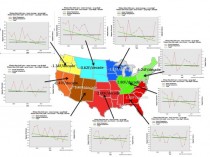
Enlarged





